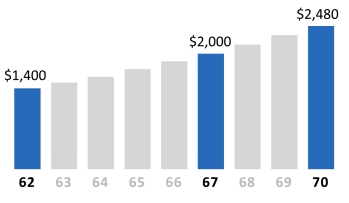
Introduction
Providing retirement benefits was a key provision of the Social Security Act of 1935. Older Americans were especially financially vulnerable during the Great Depression, and Social Security was enacted partly to provide them with some continuing income after retirement. Today, although the scope of the program has been widened through amendments to include survivor, disability, and medical insurance benefits, Social Security remains synonymous with retirement benefits.
Meeting the eligibility criteria for retirement benefits
Test your knowledge. Pick the two people you believe may be eligible for Social Security retirement benefits:
- A 64-year-old married secretary
- A 62-year-old male neurosurgeon
- A 65-year-old divorced violinist
- A 70-year-old unemployed machinist
If you picked 1 and 4, you were right. On the other hand, if you picked 2 and 3, you were also right. All of these individuals could be eligible for Social Security retirement benefits. No matter what your occupation, gender, or income level, you are eligible for Social Security retirement benefits if you are:
- Age 62 or older and a fully insured worker (you have earned 40 Social Security credits) or
- A qualified family member of a fully insured worker:
- A spouse of a retired worker (spouse must be age 62 or older unless caring for the worker’s dependent child) or
- The divorced spouse of a fully insured worker who is eligible for retirement (spouse must be retirement age unless caring for dependent child) or
- A dependent or disabled child of the retired worker
Worker’s retirement benefit
Your Social Security retirement benefit is a main source of retirement income. When you begin receiving benefits will affect how much you receive every month.
When can you start receiving retirement benefits?
Deciding when to retire and begin receiving Social Security retirement benefits is a personal decision. It can be an easy one (“I’m tired of being a sales manager; I’d rather join the Senior PGA Tour.”) or a difficult one (“My kids are in college; I want to retire, but Harvard is expensive!”). When making this decision, consider the following age requirements that will affect the amount of your Social Security benefit check:
Full retirement–If you retire at full retirement age, you will be eligible for full Social Security benefits based on 100 percent of your primary insurance amount (PIA), provided that you are fully insured. Your full retirement age depends upon the year in which you were born:
|
Birth date |
Full retirement age will be |
|---|---|
|
1943-1954 |
66 years |
|
1955 |
66 years, 2 months |
|
1956 |
66 years, 4 months |
|
1957 |
66 years, 6 months |
|
1958 |
66 years, 8 months |
|
1959 |
66 years, 10 months |
|
1960 and later |
67 years |
Note: If you were born on January 1st of any year, the full retirement age for the previous year applies.
Early retirement–The minimum age at which you can retire and receive Social Security retirement benefits is currently 62. If you retire at age 62, you will be eligible for reduced retirement benefits based on a percentage of your primary insurance amount (PIA) entitlement, provided that you are fully insured. Your retirement benefit will be reduced by 5/9ths of 1 percent (or.55556 percent) for every month between your retirement date and full retirement age, up to 36 months, then by 5/12ths of 1 percent thereafter. This reduction is permanent; when you reach full retirement age, you will not be eligible for a benefit increase.
Delayed retirement– You will increase your retirement benefit for each month that you delay receiving Social Security retirement benefits past full retirement age. Your benefit will increase by a predetermined percentage for each month you delay retirement up to the maximum age of 70. For anyone born in 1943 or later, the monthly percentage is 2/3 of 1%, and the annual percentage is 8%.
The delayed retirement credit does not affect your PIA. Even if you elect to delay receiving Social Security retirement benefits, you can still receive Medicare benefits at age 65. Remember to file an application for Medicare, even if you don’t file one for Social Security retirement benefits until later.
Retirement benefits for qualified family members
Certain family members of a fully insured worker may be eligible for retirement benefits based on the worker’s record. Retirement benefits are generally paid to family members who relied upon the worker’s income for support. Benefits paid to family members are based upon the retired worker’s PIA and paid in addition to the benefit paid to the worker. The following table outlines who these family members are, what benefits they are entitled to receive, and the basic conditions they must meet in order to be eligible for those benefits:
|
Beneficiary |
Minimum Age |
Insured status |
Conditions |
Amount of Benefit |
|---|---|---|---|---|
|
Spouse of retired worker |
62 or earlier if caring for a dependent child (under 16 or disabled) who is eligible for child’s benefits |
Worker must be fully insured. Spouse does not have to be insured |
Worker must have filed for retirement benefits before spouse is eligible |
50% of the worker’s PIA, subject to early retirement reduction, if applicable |
|
Divorced spouse of worker |
62 or earlier if caring for a dependent child (under 16 or disabled) who is eligible for child’s benefits |
Marriage must have lasted at least 10 years before final divorce date. Remarriage may affect benefit |
Worker does not have to be receiving retirement benefits but must be age 62 or older |
Usually 50% of the worker’s PIA, subject to early retirement reduction, if applicable |
|
Child of retired worker |
No minimum age, but must be under 18 or under 19 (in school). Disabled child can be over 18 if disability began before 22 |
Worker must be fully insured |
Worker must be receiving retirement benefits before child is eligible. Child in school must be a full-time student and unmarried |
Each child receives 50% of worker’s PIA. Family maximum, however, may limit this benefit |
Family benefits end when the retired worker dies. However, at that time, family members may be eligible to receive Social Security survivor benefits.
Spouse’s benefits
Spouse’s benefits are payable to the spouse of a retired worker. To be eligible, the spouse must meet one of the following conditions:
- The spouse must have been married to the worker for at least one year before applying for benefits, or
- The spouse must be the natural parent of the worker’s child, or
- The spouse must have been entitled or potentially entitled in the month before marriage to benefits from a previous spouse, surviving spouse, or parent
In addition, the spouse must be:
- Age 62 or older and eligible for a greater retirement benefit based on the spouse’s PIA than on his or her own PIA, or
- Caring for a child who is under age 16 or disabled
Once your spouse begins receiving retirement benefits, you may be eligible for a spousal retirement benefit provided that you are of minimum retirement age (currently 62). To be eligible for spouse’s benefits, you do not have to be insured for Social Security benefits based on your own earnings record. Even if you have never worked outside your home or in a job covered by Social Security, you may be eligible for spousal benefits. However, if you have worked and are eligible for benefits based on your own PIA, then you can’t elect to receive the spouse’s benefit unless it would be greater than the benefit provided by your own PIA. The amount of your spousal retirement benefit will be determined by your spouse’s PIA and your age at retirement (not your spouse’s age at retirement). If you are of full retirement age you will receive full spousal benefits. This benefit amount is 50 percent of your spouse’s PIA. If you are less than full retirement age, you will receive a reduced spouse’s benefit amount. Your benefit will be reduced by 25/36 of 1 percent (.69 percent) for each month that you are under full retirement age.
Josephine retires at full retirement age from her job as a plumber. Her husband, Mike, decides to retire early. Mike is not fully insured for retirement benefits, so he decides to apply for a spouse’s retirement benefit based on Josephine’s PIA. Since Mike is 36 months away from his full retirement age, his spouse’s benefit will be 25 percent less than his benefit would have been had he waited until full retirement age to receive spouse’s benefits (36 x.69). Thus, his retirement benefit will be 37.5 percent of Josephine’s PIA.
You may be eligible for the spouse’s retirement benefit if you are less than age 62 if you are caring for the natural child of your retired spouse and the child is under the age of 16 or disabled. Your benefit will equal 50 percent of the worker’s PIA. However, if the child’s status changes (the child becomes older than 16 or is no longer disabled), then you will no longer be eligible to receive the retirement benefit until you reach age 62.
Divorced spouse’s benefit
If you are a divorced spouse of a fully insured worker, you are eligible to receive the same spousal retirement benefit as a married spouse provided that you were:
- Married to the worker for at least 10 years before the divorce became final (unless you were already age 62 when the divorce became final), or
- Divorced for at least two years if the worker is not yet receiving retirement benefits
You must meet the same age and eligibility requirements as a married spouse with one exception: Your ex-spouse does not have to be retired in order for you to receive benefits as long as you are of minimum retirement age and you have been divorced for at least two years. However, your ex-spouse must be eligible to receive benefits even if he or she has not yet elected to begin receiving them. Benefits for a divorced spouse are calculated independently from those of a current spouse. This means that if your ex-spouse has remarried, your benefits won’t be affected. However, if you remarry, then your benefits may be affected. Like a current spouse’s benefits, your benefit will be reduced if you retire at less than full retirement age.
Child’s benefit
Children of a retired worker are entitled to Social Security retirement benefits if:
- The parent is receiving Social Security retirement benefits.
- The child is dependent upon the parent for support.
- The child is enrolled full-time in elementary or high school and is under age 18 or between the ages of 18 and 19. A child who is disabled is eligible past age 18 if the disability began before age 22.
- The child is unmarried.
The amount of child’s benefit payable to each eligible child is 50 percent of his or her retired parent’s PIA. However, a child’s benefit will often be subject to the family maximum. If the total amount of benefits paid to eligible family members based on an individual’s PIA exceeds the family maximum benefit, each child’s benefit will be reduced accordingly.
Questions & Answers
When should you file an application to receive Social Security retirement benefits?
The Social Security Administration suggests that you apply three months before the date you want your benefits to start.
Can Social Security retirement benefits be paid retroactively?
Benefits can be paid up to six months retroactively, beginning with the first month in the retroactive period in which you met entitlement requirements (other than filing an application).
When will Social Security retirement benefits end?
Your retirement benefits will end when you die. However, your spouse, children, or dependent parents may be eligible for survivor benefits based on your earnings record.
Thank you for taking the time to read this article. We hope it has given you some insight into Social Security. If you have any questions or would like more information, please feel free to contact us. We would love to hear from you. Our newsletter is a great way to stay up-to-date with our latest offerings and get helpful retirement planning tips. Signing up is easy; click here.
Broadridge Investor Communication Solutions, Inc. prepared this material for use by Social Security Benefit Planners, LLC.
Broadridge Investor Communication Solutions, Inc. does not provide investment, tax, legal, or retirement advice or recommendations. The information presented here is not specific to any individual’s personal circumstances. To the extent that this material concerns tax matters, it is not intended or written to be used, and cannot be used, by a taxpayer for the purpose of avoiding penalties that may be imposed by law. Each taxpayer should seek independent advice from a tax professional based on individual circumstances. Social Security Benefit Planners, LLC provide these materials for general information and educational purposes based upon publicly available information from sources believed to be reliable — we cannot assure the accuracy or completeness of these materials. The information in these materials may change at any time and without notice.
Social Security Benefit Planners, LLC and its affiliates are in no way associated with or approved, endorsed, or authorized by the Social Security Administration.



 and the political slant, Social Security has been described as everything from a program in need of some adjustments to one in crisis requiring immediate, drastic reform.
and the political slant, Social Security has been described as everything from a program in need of some adjustments to one in crisis requiring immediate, drastic reform.
















 working and the amount you’ve earned. When you begin taking Social Security benefits also greatly affects the size of your benefit.
working and the amount you’ve earned. When you begin taking Social Security benefits also greatly affects the size of your benefit.

